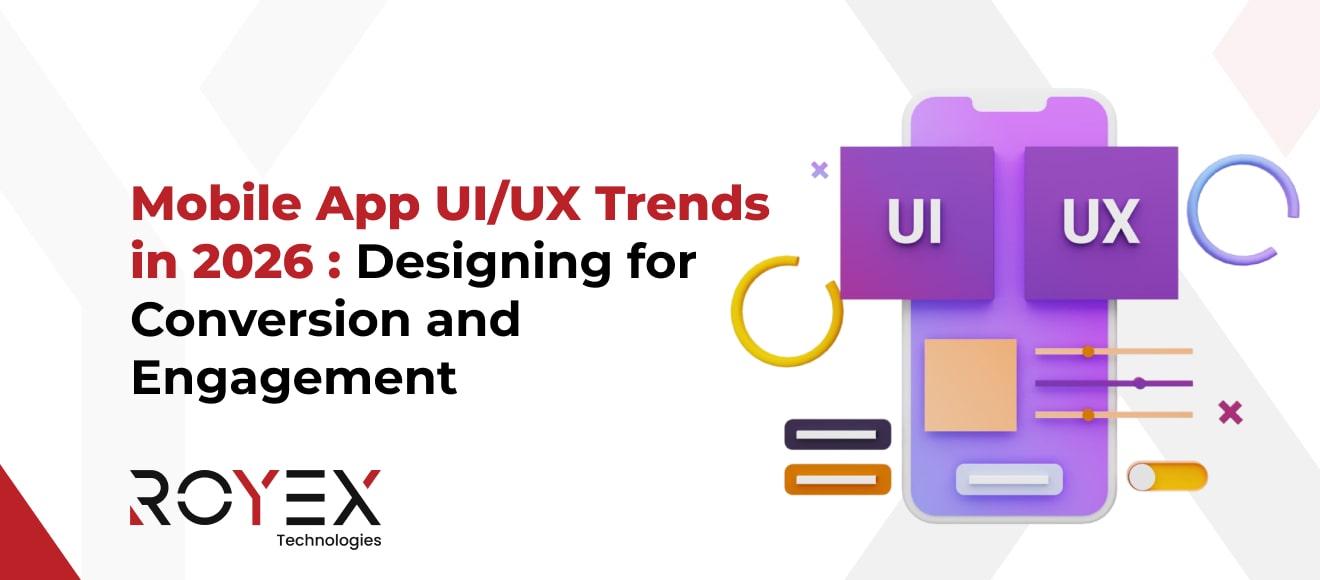
Mobile App UI/UX Trends in 2026 : Designing for Conversion and Engagement
The year 2026 marks a new era for mobile applications. With the proliferation of AI-powered interfaces, hyper-personalized experiences, voice-first navigation, and immersive AR/VR design, UI/UX is no longer just about aesthetics—it’s about driving conversion, retention, and engagement. Businesses in the UAE, where smartphone penetration exceeds global averages and 5G coverage is mainstream, face a particularly competitive digital environment. A well-designed mobile app isn’t optional; it’s the lifeline of growth.
This comprehensive guide explores the top mobile app UI/UX trends for 2026, why they matter for conversion and engagement, and how UAE businesses can capitalize on them. You’ll also discover regional stats, insights into consumer behavior, and finally, why Royex Technologies is the best partner for mobile app development Dubai—helping businesses craft experiences that engage, convert, and scale.
The State of Mobile in the UAE: Why UI/UX Matters More Than Ever
Before diving into trends, let’s look at the unique digital reality of the UAE:
-
Smartphone penetration: The UAE ranks among the highest globally, with penetration rates well above 95%. Apps are the default gateway for banking, shopping, entertainment, travel, and services.
-
5G infrastructure: Nationwide coverage supports high-fidelity video, AR/VR, and low-latency experiences, setting the stage for more demanding UI/UX design standards.
-
Multilingual audience: With a large expat population, Arabic (RTL) and English bilingual interfaces are table stakes, not optional.
-
E-commerce boom: Mobile commerce contributes the majority of digital sales, with projected double-digit CAGR through 2026. A single second delay in load time can drastically impact conversions.
-
User expectations: UAE consumers are digitally savvy, influenced by luxury design standards, and demand frictionless interactions.
For businesses in this environment, conversion-focused UI/UX design is essential—not just to attract attention but to drive tangible outcomes: purchases, bookings, leads, and loyalty.
Mobile App UI/UX Trends in 2026
1) AI-Driven Personalization at Scale
Personalization is no longer just showing a customer their name on the screen. By 2026, AI enables:
-
Predictive personalization: Apps anticipate user needs before they’re expressed (e.g., food delivery apps suggesting meals before lunch hours).
-
Dynamic layouts: Home screens adapt in real time based on context (time of day, location, previous usage).
-
Hyper-segmentation: UAE shoppers see different offers and products depending on cultural background, purchase history, and payment preferences.
Impact on conversion: Personalized flows reduce friction and improve relevance, increasing conversion rates by up to 30%.
2) Voice-First & Conversational Interfaces
With voice assistants and multilingual NLP becoming mainstream, mobile apps are embedding voice-first navigation:
-
Bilingual voice commands: Seamless switch between Arabic and English in the UAE.
-
Voice commerce: Search, browse, and purchase using natural speech.
-
Conversational support: AI chatbots integrated into mobile apps for instant help.
Engagement impact: Voice-first interfaces simplify tasks, particularly for older demographics or users multitasking on the go.
3) Gesture-Driven Interactions
In 2026, gestures replace many taps:
-
Swipe-based navigation beyond left/right—diagonal, pinch, and hover gestures are mainstream.
-
Micro-interactions like pull-to-refresh with animation, swipe-to-reveal offers, and haptic feedback for confirmation.
-
Invisible UI: Interfaces rely on intuitive gestures instead of cluttered buttons.
Engagement impact: Gestures create a sense of control and playfulness, keeping users engaged longer.
4) Immersive AR & Mixed Reality Experiences
AR has moved beyond gimmicks:
-
Retail apps: Try-on experiences for fashion, eyewear, and cosmetics.
-
Real estate apps: Virtual tours integrated with geolocation.
-
Hospitality apps: Augmented experiences of destinations, menus, and hotel rooms.
With 5G and edge computing, rendering is seamless in the UAE.
Conversion impact: Immersive AR reduces purchase hesitation, boosting conversion by creating buyer confidence.
5) Dark Mode, Adaptive UI & Energy Efficiency
As sustainability and device efficiency gain traction:
-
Adaptive themes: Apps switch between light/dark modes automatically based on user context.
-
Battery-optimized UI: Animations and high-res media scale intelligently to conserve energy.
-
Eco-conscious design cues: Visuals emphasize sustainability, resonating with younger, eco-aware UAE users.
Engagement impact: Comfort + efficiency = longer sessions, fewer drop-offs.
6) Accessibility as a Core Design Standard
Accessibility is no longer an afterthought in 2026. Apps must comply with WCAG 3.0 and local guidelines:
-
Text scaling with Dynamic Type for both Arabic and English.
-
Screen reader compatibility with natural language for bilingual experiences.
-
Color contrast standards for visibility in sunlight-heavy UAE environments.
Conversion impact: Accessible apps capture wider audiences, including older users and people with impairments, expanding market reach.
7) Super-App Modular Interfaces
Super-apps dominate in Asia and are rapidly rising in the Middle East. The trend in 2026:
-
Modular dashboards: Add/remove services like food delivery, travel, and shopping.
-
Unified wallets & loyalty: All-in-one payment and rewards system.
-
Contextual surfaces: Users see only the modules they engage with, reducing clutter.
Engagement impact: Users remain in-app longer since it serves multiple needs in one place.
8) Micro-Animations & Emotional Design
Animations in 2026 go beyond delight—they communicate intent:
-
Feedback loops: Animations confirm actions (like checkmarks for purchases).
-
Emotion-driven design: Colors, sound cues, and motion evoke joy or urgency.
-
Localized storytelling: Apps in the UAE embed cultural cues into animations (e.g., Ramadan-specific themes).
Engagement impact: Positive emotions boost user satisfaction, loyalty, and shareability.
9) Data-Driven UI Optimization
With advanced analytics and AI-driven A/B testing, UI evolves dynamically:
-
Layouts automatically adjust to maximize click-through and conversion rates.
-
AI highlights drop-off points and suggests optimized user journeys.
-
Real-time personalization ensures no two users have identical experiences.
Conversion impact: Apps continually improve without waiting for big redesigns.
10) Privacy-Centric UX
Users demand control over their data. In 2026:
-
Granular consent dashboards allow users to toggle what data is collected.
-
Contextual privacy nudges explain why permissions are needed.
-
Anonymous modes for browsing/shopping without logging in.
Conversion impact: Transparency builds trust, leading to higher sign-ups and completed purchases.
Regional Context: UI/UX for UAE and the Middle East
-
Bilingual UX: Every app must handle Arabic (RTL) alongside English, requiring thoughtful typography, mirroring, and layout logic.
-
Cultural design cues: Respect for religious and cultural events (Ramadan, Eid) integrated into seasonal campaigns.
-
Payment diversity: Apps must integrate Apple Pay, Google Pay, local cards, and BNPL options.
-
Youth-driven adoption: Over 60% of UAE residents are under 35—Gen Z and millennials expect fresh, modern interfaces.
-
Luxury influence: The UAE’s luxury retail sector inspires sleek, minimal, premium-feel app designs.
The Link Between UI/UX and Conversion
Conversion is not accidental. It’s engineered through:
-
Frictionless onboarding: Simple sign-ups with biometrics or social logins.
-
Streamlined checkout: One-tap payment flows.
-
Trust signals: Secure design patterns, transparent data handling.
-
Personalized nudges: Contextual recommendations and upsells.
Each UI/UX trend in 2026 contributes to reducing friction, building trust, and guiding users toward action.
Designing for Engagement
Engagement strategies are equally vital:
-
Gamification: Points, badges, and challenges to retain users.
-
Push notification UX: Personalized, non-intrusive reminders tied to real-time behavior.
-
Community features: Ratings, reviews, and social sharing built into flows.
-
Content-first design: Integrating short-form videos and live streams within apps.
Engagement ensures users return consistently, boosting LTV (lifetime value).
Future Outlook: Beyond 2026
-
Ambient apps: Apps anticipate needs even without active use (context-aware notifications).
-
Full AR commerce: Users “walk” through virtual malls on their phones.
-
Brain-computer interface experiments: Still early, but UX is preparing for neural input in niche sectors.
-
Cross-device continuity: Apps seamlessly shift between mobile, wearables, cars, and VR headsets.
The future of UI/UX will blend prediction, immersion, and trust.
Why Royex Is the Best Choice for Mobile App Development Dubai
As businesses look to harness these trends, the right partner is essential. Here’s why Royex is the leader in mobile app development dubai:
1) Cutting-Edge Expertise
Royex stays ahead of design and technology shifts—implementing AI personalization, AR interfaces, voice-first design, and gesture-based navigation before they become industry norms.
2) UAE-Centric Focus
We understand the bilingual, multicultural, mobile-first nature of the UAE market. From RTL Arabic design systems to local payment integrations, we build apps that resonate locally while performing globally.
3) Conversion-Driven Design
Royex doesn’t just build apps—we engineer them for conversion and engagement. Every flow is optimized for outcomes: sign-ups, purchases, loyalty, and retention.
4) End-to-End Development
From strategy and UX design to engineering, testing, and growth optimization, Royex covers the full lifecycle. Our continuous iteration ensures your app evolves with trends.
5) Proven Across Industries
We’ve built mobile apps for retail, fintech, hospitality, logistics, government, and entertainment—each optimized for performance and user delight.
6) Partnership Model
At Royex, we operate as true partners, aligning our metrics with your KPIs—ensuring measurable ROI from every sprint.
The mobile landscape in 2026 is defined by personalization, immersion, accessibility, and trust. Businesses in the UAE can’t afford outdated designs or clunky experiences. Instead, they must adopt modern UI/UX practices that turn users into loyal customers.
For those seeking mobile app development in Dubai, Royex is the partner of choice—combining local market expertise, cutting-edge design trends, and a relentless focus on conversion and engagement.
The future of apps is here. The only question is: Will your business be ready to engage, convert, and grow?





